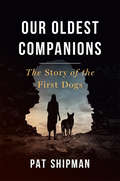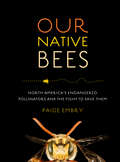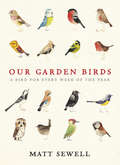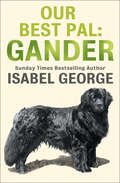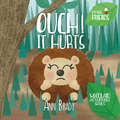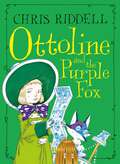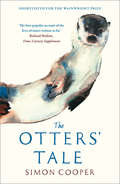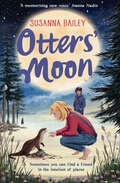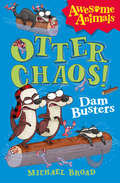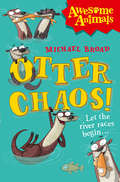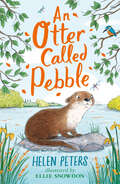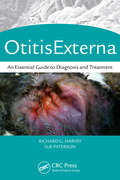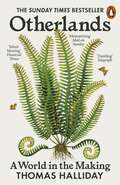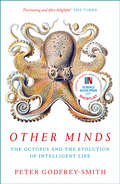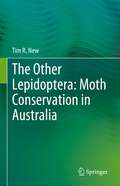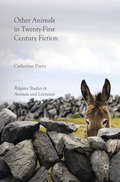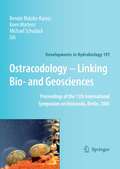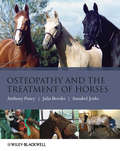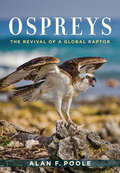- Table View
- List View
Our Oldest Companions: The Story of the First Dogs
by Pat ShipmanHow did the dog become man’s best friend? A celebrated anthropologist unearths the mysterious origins of the unique partnership that rewrote the history of both species. Dogs and humans have been inseparable for more than 40,000 years. The relationship has proved to be a pivotal development in our evolutionary history. The same is also true for our canine friends; our connection with them has had much to do with their essential nature and survival. How and why did humans and dogs find their futures together, and how have these close companions (literally) shaped each other? Award-winning anthropologist Pat Shipman finds answers in prehistory and the present day. In Our Oldest Companions, Shipman untangles the genetic and archaeological evidence of the first dogs. She follows the trail of the wolf-dog, neither prehistoric wolf nor modern dog, whose bones offer tantalizing clues about the earliest stages of domestication. She considers the enigma of the dingo, not quite domesticated yet not entirely wild, who has lived intimately with humans for thousands of years while actively resisting control or training. Shipman tells how scientists are shedding new light on the origins of the unique relationship between our two species, revealing how deep bonds formed between humans and canines as our guardians, playmates, shepherds, and hunters. Along the journey together, dogs have changed physically, behaviorally, and emotionally, as humans too have been transformed. Dogs’ labor dramatically expanded the range of human capability, altering our diets and habitats and contributing to our very survival. Shipman proves that we cannot understand our own history as a species without recognizing the central role that dogs have played in it.
Our Native Bees: North America's Endangered Pollinators and the Fight to Save Them
by Paige EmbryOur Native Bees is the result of Paige Embry&’s yearlong quest to learn more about the forgotten, yet fundamental, native bees of North America.
Our Garden Birds
by Matt SewellIn this beautiful, collectible new volume, street artist Matt Sewell offers his own unique take on 52 of our favourite British garden birds. Since its first appearance in July 2009, Matt's 'Bird of the Week' feature for the Caught by the River website has quickly become a cult hit. His pop-art watercolours are distinctive and enchanting, as are his innovative descriptions, which see great tits 'bossing the other birds around', the 'playful yet shy buoyancy' of bullfinches and the 'improbable' nature of the waxwing ('like a computer-generated samurai finch').With 52 birds, one for each week of the year, this delightful gift book will appeal to bird watching enthusiasts, children and adults, and art and illustration fans alike.
Our Best Pal: Gender
by Isabel GeorgeAn inspiring and heart-warming short story of canine devotion and bravery.
Ouch! It Hurts (Little Friends: Woodland Adventures Series #4)
by Ann BradyBobo the Baby Rabbit is running around outside with his brothers and sisters. When he gets tired he goes to sit down and sits on top of Emily Hedgehog who quickly rolls into a ball, frightening poor Bobo and pricking him with her spikes. Bobo doesn’t know about Emily Hedgehogs spikes, do you? Emily tells him why she has them and how they protect her. Once Bobo knows that Emily didn’t mean to hurt him he and Emily become good friends.
Ottoline and the Purple Fox (Ottoline #4)
by Chris RiddellOttoline is back in Ottoline and the Purple Fox, a beautifully illustrated adventure from former Children's Laureate, Chris Riddell.Ottoline and Mr Munroe love puzzles, clues and mysteries. One day, they meet an enigmatic purple fox, who offers to take them on a night-time urban safari. The fox shows them all the hidden animals of the city and Ottoline makes notes on them in her field notebook. Mr Munroe is making notes too - on the anonymous poems he finds stuck to lampposts on their journey. Who is the secretive poet, and how can he and Ottoline help them mend their broken heart?
The Otters’ Tale
by Simon CooperShortlisted for THE WAINWRIGHT PRIZE 2017 ‘The best popular account of the lives of otters written so far’ Richard Shelton, Times Literary Supplement
Otters' Moon
by Susanna BaileyThe brand new novel from the critically-acclaimed author of Snow Foal. A beautiful and heart-wrenching middle grade debut for kids aged 9 to 12, set in the beautiful wilds of a remote Scottish island. Perfect for fans of Jacqueline Wilson, Cathy Cassidy, Tarka the Otter and Gill Lewis.
Otter Chaos - The Dam Busters: Dam Busters (Awesome Animals)
by Michael BroadFrom the award-winning author of Space Mutts comes the second otterly chaotic title! Part of the Awesome Animals range – the funniest fiction staring the wildest wildlife!
Otter Chaos!: Let The River Races Begin... (Awesome Animals)
by Michael BroadThe sixth animal in the hilarious AWESOME ANIMALS series – awesome adventures with the wildest wildlife.
An Otter Called Pebble (The Jasmine Green Series #7)
by Helen PetersThe seventh in a fantastic series of animal stories for younger readers by Waterstones Children's Book Prize-shortlisted author Helen Peters, with beautiful black-and-white illustrations by Ellie Snowdon. Jasmine and Tom are amazed to spot a baby otter alone on the riverbank. When the little cub is swept downstream, they risk everything to rescue her. But where is her family? Can Jasmine and Tom find Pebble's home before it's too late? Brilliant storytelling that will make you laugh and cry, this is Dick King-Smith for a new generation. Look out for Jasmine's other adventures! A Piglet Called Truffle A Duckling Called Button A Sheepdog Called Sky A Kitten Called Holly A Lamb Called Lucky A Goat Called Willow
Otitis Externa: An Essential Guide to Diagnosis and Treatment
by Richard G. Harvey BVSc DVD Dip ECVD FSB Sue PatersonThe investigation and management of ear disease occupies a significant portion of a veterinary clinician's time. Otitis externa, in particular, is likely to be seen by a busy small animal clinician at least once a day. Otitis Externa: An Essential Guide to Diagnosis and Treatment provides a comprehensive source of information on the relevant struct
Otherlands: A World in the Making
by Thomas Halliday'The best book on the history of life on Earth I have ever read' Tom Holland'Epically cinematic... A book of almost unimaginable riches' Sunday TimesThis is the past as we've never seen it before. Otherlands is an epic, exhilarating journey into deep time, showing us the Earth as it used to exist, and the worlds that were here before ours. Travelling back in time to the dawn of complex life, and across all seven continents, award-winning young palaeobiologist Thomas Halliday gives us a mesmerizing up close encounter with eras that are normally unimaginably distant. Halliday immerses us in a series of ancient landscapes, from the mammoth steppe in Ice Age Alaska to the lush rainforests of Eocene Antarctica, with its colonies of giant penguins, to Ediacaran Australia, where the moon is far brighter than ours today. We visit the birthplace of humanity; we hear the crashing of the highest waterfall the Earth has ever known; and we watch as life emerges again after the asteroid hits, and the age of the mammal dawns. These lost worlds seem fantastical and yet every description - whether the colour of a beetle's shell, the rhythm of pterosaurs in flight or the lingering smell of sulphur in the air - is grounded in the fossil record. Otherlands is a staggering imaginative feat: an emotional narrative that underscores the tenacity of life - yet also the fragility of seemingly permanent ecosystems, including our own. To read it is to see the last 500 million years not as an endless expanse of unfathomable time, but as a series of worlds, simultaneously fabulous and familiar.
Other Minds: The Octopus And The Evolution Of Intelligent Life
by Peter Godfrey-SmithBBC R4 Book of the Week ‘Brilliant’ Guardian ‘Fascinating and often delightful’ The Times What if intelligent life on Earth evolved not once, but twice? The octopus is the closest we will come to meeting an intelligent alien. What can we learn from the encounter?
The Other Lepidoptera: Moth Conservation in Australia
by Tim R. NewConservation interest in moths, by far the predominant components of Lepidoptera, lags far behind that for butterflies, for which conservation practice provides many well-established lessons for extension to their near relatives. The needs of moths are at least as great, but their greater richness and variety, and far poorer documentation of diversity and biology over much of the world contribute to this lack of attention. Australia’s rich moth fauna, largely endemic and of global interest, illustrates many of the problems of developing wider interest and support for moth conservation. Numerous species (perhaps half the total fauna) are undescribed, and many are ecological specialists in restricted and vulnerable environments over small parts of the continent. Establishing their conservation status and needs whilst accepting that foundation knowledge is highly incomplete and much species-focused conservation is impracticable provides complex problems in setting priorities, based largely on wider diversity and effective advocacy. Most Australian vegetation systems, from grassland to forest and from sea-level to alpine zones, have been eroded in extent and quality since European settlement, resulting in massive habitat changes for native insects and to leave fragmented (and commonly degraded) remnants in which moths and others may persist. Recent surveys continue to increase recorded moth richness, reveal local faunal peculiarities, and indicate how assemblage changes may mirror wider environmental changes. This book is an overview of advances in documenting and interpreting moth diversity and ecology, to show how information from better-studied moth faunas can help in planning conservation of Australia’s moths through measures such as understanding the moths themselves by increased surveys and study, the factors influencing their diversity and wellbeing, and how such threats may be countered through increased coordinated conservation interest, commitment and management.
Other Animals in Twenty-First Century Fiction
by Catherine ParryThis book is about ordinary animals and how they are imagined in twenty-first century fiction. Examining contemporary animal representations and the fraught and potent distinctions humans fashion between themselves and all other animals, it asks how a range of novels make, re-make or un-make traditional conceptions of the creatures we love, admire, eat, vilify and abuse. Other Animals’ detailed readings of horses, an animalised human, a donkey, ants, chickens and chimpanzees develop new critical practices in Literary Animal Studies. They explore the connections between fictional animal representation, narrative form, ethics, and the lives and warm bodies of the real-world creatures that precede and exceed our imagination. Human-animal relationships are conditioned by our imaginative shapings of other animals, and by our sense of distinction from them, and Other Animals opens out how fictional animal forms and tropes respond to, participate in, or challenge the ways animals’ lives are lived out in consequence of human imaginings of them.
Other Animals in Twenty-First Century Fiction
by Catherine ParryThis book is about ordinary animals and how they are imagined in twenty-first century fiction. Examining contemporary animal representations and the fraught and potent distinctions humans fashion between themselves and all other animals, it asks how a range of novels make, re-make or un-make traditional conceptions of the creatures we love, admire, eat, vilify and abuse. Other Animals’ detailed readings of horses, an animalised human, a donkey, ants, chickens and chimpanzees develop new critical practices in Literary Animal Studies. They explore the connections between fictional animal representation, narrative form, ethics, and the lives and warm bodies of the real-world creatures that precede and exceed our imagination. Human-animal relationships are conditioned by our imaginative shapings of other animals, and by our sense of distinction from them, and Other Animals opens out how fictional animal forms and tropes respond to, participate in, or challenge the ways animals’ lives are lived out in consequence of human imaginings of them.
Ostrich (UEB Uncontracted)
This page shows an ostrich from the side with its small head in the top left of the page and tail at the centre right. There is a locator dot shown, which will be at the top left of the page when the image is the right way up.The ostrich is facing to the left so one eye can be found, and its beak is open. Directly down from its head, its long, slender, bare neck leads to its large, black feathered body.The ostrich, despite being flightless, has two large strong wings. One of these, with white feathers at the tip is shown in the centre of the image. To the right of its wing is its white floppy feathered tail. The ostrich stands on two very long, bare legs, with large toes and claws at the end.
Ostrich (UEB Contracted)
This page shows an ostrich from the side with its small head in the top left of the page and tail at the centre right. There is a locator dot shown, which will be at the top left of the page when the image is the right way up.The ostrich is facing to the left so one eye can be found, and its beak is open. Directly down from its head, its long, slender, bare neck leads to its large, black feathered body.The ostrich, despite being flightless, has two large strong wings. One of these, with white feathers at the tip is shown in the centre of the image. To the right of its wing is its white floppy feathered tail. The ostrich stands on two very long, bare legs, with large toes and claws at the end.
Ostrich (Large Print)
This page shows an ostrich from the side with its small head in the top left of the page and tail at the centre right. There is a locator dot shown, which will be at the top left of the page when the image is the right way up.The ostrich is facing to the left so one eye can be found, and its beak is open. Directly down from its head, its long, slender, bare neck leads to its large, black feathered body.The ostrich, despite being flightless, has two large strong wings. One of these, with white feathers at the tip is shown in the centre of the image. To the right of its wing is its white floppy feathered tail. The ostrich stands on two very long, bare legs, with large toes and claws at the end.
Ostracodology - Linking Bio- and Geosciences: Proceedings of the 15th International Symposium on Ostracoda, Berlin, 2005 (Developments in Hydrobiology #197)
by Renate Matzke-Karasz Koen Martens Michael SchudackThe great diversity of ostracod applications in biology and palaeontology is clearly illustrated by eighteen papers from the 15th International Symposium on Ostracoda. Collectively, the contributions provide a comprehensive update of ongoing research and the latest findings in ostracod sciences. You’ll learn how ostracods are used as model groups in a variety of research studies, ranging from evolutionary biology to climate change.
Osteopathy and the Treatment of Horses
by Anthony Pusey Julia Brooks Annabel JenksWritten by pioneering and internationally-renowned specialists in the field, this text provides clinically-orientated information on osteopathy as a treatment for horses. It explains the scientific rationale of how osteopathy works in animals, as well as providing a detailed working guide to the technical skills and procedures you need to know to perform safe and effective osteopathic procedures. Drawing on well established practices for humans this book provides details on the full variety of diagnostic and therapeutic osteopathic procedures that can be used on horses. Full of practical information, it demonstrates how professionals treating equine locomotor problems can adapt different procedures in different clinical settings. Over 350 colour images and detailed step-by-step instructions demonstrate the procedures and practice of osteopathy. Covers treatment both with and without sedation and general anaesthetic. This comprehensive text is written for students and practitioners of osteopathy with an interest in treating horses. It will also be useful to other allied therapists, and to veterinary practitioners who want to know more about the treatment of musculoskeletal problems.
Osteopathy and the Treatment of Horses
by Anthony Pusey Julia Brooks Annabel JenksWritten by pioneering and internationally-renowned specialists in the field, this text provides clinically-orientated information on osteopathy as a treatment for horses. It explains the scientific rationale of how osteopathy works in animals, as well as providing a detailed working guide to the technical skills and procedures you need to know to perform safe and effective osteopathic procedures. Drawing on well established practices for humans this book provides details on the full variety of diagnostic and therapeutic osteopathic procedures that can be used on horses. Full of practical information, it demonstrates how professionals treating equine locomotor problems can adapt different procedures in different clinical settings. Over 350 colour images and detailed step-by-step instructions demonstrate the procedures and practice of osteopathy. Covers treatment both with and without sedation and general anaesthetic. This comprehensive text is written for students and practitioners of osteopathy with an interest in treating horses. It will also be useful to other allied therapists, and to veterinary practitioners who want to know more about the treatment of musculoskeletal problems.
Ospreys: The Revival of a Global Raptor
by Alan F. PooleOspreys are one of the few bird species that are found throughout the world. From forests in Hokkaido to rivers in Oregon and islands off Australia, Ospreys steal the show as nature lovers easily watch them build their massive nests and tend to their young. The fact that the Osprey is one of the few large birds that can hover adds to its mystique, and to watch it plunge into the water, emerging with a fish clutched in its talons, is truly a sight one will remember. As widespread as Ospreys are, not long ago they were under threat of extinction. During the 1950s and '60s, scientists tied the decline of Osprey populations to the heavy use of DDT and other human pollutants. In the 1980s, Ospreys began a slow recovery due to the efforts of conservationists and through the resilience of the adaptable raptors themselves. Today they are again considered common in most parts of the world, although some populations remain threatened.In this gorgeously illustrated book, Alan F. Poole, one of America's premier Osprey experts, has written a lyrical expos;© of these majestic creatures, describing their daily habits and exploring their relationship with the environment. Ospreys celebrates the species' miraculous recovery from contaminants and hunters, chronicles their spectacular long-distance migrations, and unveils their vital role in bringing life to coastal habitats. Few other birds have such a hold on the human imagination. This book shows us why.
Ospreys: The Revival of a Global Raptor
by Alan F. PooleOspreys are one of the few bird species that are found throughout the world. From forests in Hokkaido to rivers in Oregon and islands off Australia, Ospreys steal the show as nature lovers easily watch them build their massive nests and tend to their young. The fact that the Osprey is one of the few large birds that can hover adds to its mystique, and to watch it plunge into the water, emerging with a fish clutched in its talons, is truly a sight one will remember. As widespread as Ospreys are, not long ago they were under threat of extinction. During the 1950s and '60s, scientists tied the decline of Osprey populations to the heavy use of DDT and other human pollutants. In the 1980s, Ospreys began a slow recovery due to the efforts of conservationists and through the resilience of the adaptable raptors themselves. Today they are again considered common in most parts of the world, although some populations remain threatened.In this gorgeously illustrated book, Alan F. Poole, one of America's premier Osprey experts, has written a lyrical expos;© of these majestic creatures, describing their daily habits and exploring their relationship with the environment. Ospreys celebrates the species' miraculous recovery from contaminants and hunters, chronicles their spectacular long-distance migrations, and unveils their vital role in bringing life to coastal habitats. Few other birds have such a hold on the human imagination. This book shows us why.
